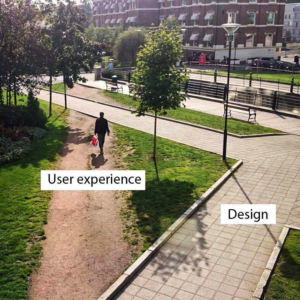Congratulations, you creative wunderkind! So, you came up with a brilliant app idea? Excellent. That’s very exciting. However, you’re Googling “is my app idea worth pursuing?” or “is my app idea worth app development?”
And that’s a great question to ask. Because while it’s probable your idea is fantastic, not all app ideas are viable business ventures. Some are just excellent ideas that should be put in the “Ice Box”— (i.e., the “Epic Ideas But Let’s Table for Now” category.)
Answering this question is why we here at Goji Labs—a product and app development consultancy (with a five-star Clutch rating, humbly #1 in Los Angeles)—are here. So let’s get into it.
TLDR; Contents
“Strategizing by Thinking”: Evaluating the App Idea
First off, you should make sure your app idea is, at least in theory, an effective solution to a specific problem statement. Lyft’s problem statement is streamlined, on-demand transportation. Clockify is an app that helps users time manage and time track projects. Both of these are examples of straightforward problem statements.
Your app idea also needs to be relevant. So whether it addresses relevant needs, replaces outdated technology or incumbent solutions, or is based on cultural trends or macro events—relevance is essential.
In other words, the last VCR was manufactured 2016—so probably not the best bandwagon to hop on. But an app that connects a VCR to phones and allows users to screen mirror their collection of old Disney tapes? Relevant.
Establishing App Idea Need – Market Validation
Once you’ve checked the theoretical perspective of your app idea, it’s time to do some math. And while we all thought we left introductory statistics back in high school, unfortunately, we thought wrong ?
We’ll give a brief overview here of market validation—but if you’d like to read our longer explanation, you can find it here.
Questions to Ask
There are several basic questions you should answer. These questions revolve around:
- What is the value proposition of my app idea? [business case and problem statement]]
- Which problems does my app solve? [benefits to the user]
- Who is my target audience? [who has the problems your app solves?]
- Is my app idea marketable? [are there effective marketing channels for your target audience access?]
All of these questions, of course, inform the answer to The Golden Question:
Do my market analysis (estimations of TAM, SAM, and SOM) and predicted revenue justify the resources needed for app development and deployment?
Since the latter question has a rather long answer, we’ve answered the budgeting and cost side of the golden question in our App Development Cost and Budgeting post. Today, however, we’ll certainly cover app idea viability.
Flesh Out the App Idea
Here is your initial stab at drawing your app. First, decide on exactly which solutions you’d like to offer. From there, you can decide on the features of the app and how they come together. Which parts are the most important [and therefore potential options for the minimum viable product] and which can be introduced in later app development?
You can use workflows, diagrams, doodles, note cards—organize how you’d like to present your app to your users. And remember—this is all preliminary “strategy by thinking.” Before jumping into development, you’ll need robust data to back up your theories.
Identifying Your Target Audience
1. List out the benefits of each feature.
Which doesn’t really need further elaboration. List out each feature and all of the benefits it offers to your target audience. Sounds simple, but it’s a crucial first step.
2. Create user Stories and Personas
From listing out the benefits of each feature, you can move on to brainstorming which consumers have the problems or needs your app addresses. Identify them by the following:
- Geographic characteristics
- Demographic (education level, age, occupation, etc.)
- Psychographic (personality, values, lifestyle, etc.)
- Behavioral characteristics (how users interact with products in general, etc.)
Based on these characteristics, you can create “Epics” – or broad, general narratives for explaining why a specific type of user would use your app. Then, you can break down these “epics” into user personas and their “stories.” These are both more granular narratives based on users grouped by specific characteristics.
These stories should be persona-specific. Something along the lines of:
“As a (persona/user), I want to (goal), so that (reason for their goal).”
3. Get some data
Once you have your personas and theorized target audience, it’s time to ask them! Put out questionnaires and surveys, and interview your potential users. Find them through forums, Facebook groups, survey companies, and even interact in person at places they frequent. You can ask:
- Their characteristics (demographics, psychographics, location, behaviors)
- Do they have the needs your app idea is addressing?
- How do they rank relevant painpoints from least to greatest?
- What would they be willing to pay for your solution?
You should also use existing data to confirm (or disprove) your theories about your users. But more on that next section.
The important thing here is to try and nix all of your assumptions with data. Founding a company is anyways full of uncertainties, so you should try to eliminate your assumptions as thoroughly as possible. So, whether the data you collect confirms (woohoo!) or disproves what you think, it will 10017% serve you in the long run.
Trends
Back to existing data. Having primary data (meaning what you hear directly from the potential users) is super important as it’s customized to your solution. Primary data also gives you a competitive advantage over those who don’t know what you do. However, it’s likely confined to your reach. So it’s also important to also collect information that’s already out there.
General Data
Which you can find through Gartner, PewInternet, Quantcast, and Surveymonkey—to name a few. What are people’s painpoints, and how do they relate to their demographics? Who are the biggest players in the industry, and how do they do things?
Funding
What industries and industry segments are booming with funding, and why? Which aren’t? You can find excellent information about the industry outlook from math that VCs, angel investors, and crowdfunding sites have already done. Checking out CrunchBase and industry-specific online journals is a great place to start.
Social and Cultural
Ah, the zeitgeist. What’s popular or on consumers’ minds right now? Social movements, emerging needs, powerful cultural influences, and influencers?
For instance, I hear Tik Tok is a popular thing among The Youths. And while I don’t necessarily have the desire to broadcast myself body rolling to the world (nor do I have the coordination to do so), if you think you’re targeting a generally younger crowd, find out what they think is—ahem—“lit” or “unlit.”
SocialBlade, SproutSocial, and even GoogleTrends are your friends here.
Search Terms and Related Search Terms
Speaking of GoogleTrends, you should also definitely examine trends of relevant keywords, search terms, and related search terms. Search trends are a great way to get an insight into user’s minds and thinking. What are they Googling, how are they searching for it, and how does that data support your assumptions about need, user characteristics, and willingness to spend?
App Stores
Because there’s nothing wrong with checking out your competition or related alternative solutions. So, check out the Top Grossing page, number of downloads, and reviews. What qualitative and quantitative information can you find about competing apps’ success, popularity, and usage? How does it reflect on your app idea and assumptions?
“Strategizing by Doing” – Testing App Idea Market Fit
Before App Development
We’ve already touched on contacting your potential customers to investigate needs, confirm user characteristics, and get feedback on your app idea. Surveys, questionnaires, and interviews are essential to prove your idea is viable, along with robust existing data.
After App Development
After knowing your target audience well and confirming need and demand for your app idea, the next step is to build an excellent minimum viable product (MVP.) An MVP is a high-fidelity model of your app idea that will have enough features and be built well so that you can begin to gain traction.
Traction is key here—you want to be able to start collecting data on actual users. Who they are, what features they use, how they use the app, and where you might be losing them.
Whenever or wherever appropriate, it’s also a good idea to insert a short questionnaire or require the user to enter in some basic, non-invasive information. At this preliminary point in development (but also at every point), this is a way to collect essential information. For example, you’ll be able to see who’s logging in and find trends between their personas and how they use your app. These usage trends will be critical for information future app development and iterations.
Prototype testing
AKA, checking out how users are using the app. Which features are most popular? How do users navigate between them? Are there functionalities that consistently cause users to exit?

Or asking your users to complete pre-determined tasks and measuring their success and reactions.
Where are the points of failure? Which target audience segment does best and worst? How do the workflows look regarding task accomplishment?
Are they what you expected with your design, or did users find and prefer other surprising ways of doing things [desire paths, anyone?]
Questions to Ask
During prototype testing, and especially usability testing, it’s a good idea to add in an optional survey to capture data on user experience. For example, you can ask questions such as:
- What were your goals for using this app?
- Were you able to accomplish ___?
- What do you think are the most valuable features and why?
- Was it easy to use this app?
- Why did you do ____?
Consulting with Product and App Development Experts
There are risks and uncertainties in every business venture. This is why, whether you’re a non-technical or technical partner, it’s essential to consult with those experienced with facilitating the product and app development and deployment.
We like to sort these risks out into three categories:
- Product risk: the risk that comes with embarking on any new product venture.
Mitigate by: research, a meticulous product strategy, and an excellent MVP. - Technical risk: the risk that comes with investing in unsustainable or unscalable technical development.
Mitigate by: choosing an experienced developer invested in the long-term success of your application. - Domain expertise risk: the risk of developing your product with lacking general or technical context.
Mitigate by: doing tons of research on your industry and choosing a long-term development partner with domain expertise or the bandwidth to develop it.
All of these risks can be mitigated by choosing the right development partner—because who else would be an expert on product deployment than those who do it for a living?
______________________________________________________________________________________
Coincidentally, hi, we’re Goji Labs—a product and app development consultancy with experience in designing, researching, and deploying hundreds of apps.
Looking to develop a new app or revamp an existing one?
Have any general questions about who we are and our authority on the subject?
Reach us at GojiLabs.com.
– Goji Labs




